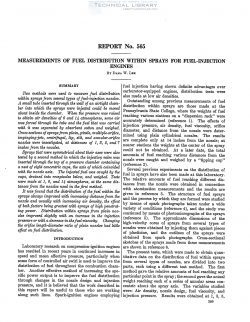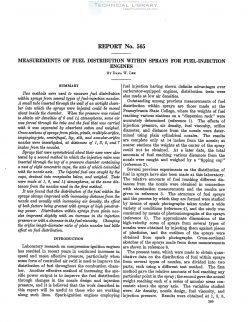naca-report-565

- Version
- 169 Downloads
- 1.53 MB File Size
- 1 File Count
- August 30, 2016 Create Date
- August 30, 2016 Last Updated
National Advisory Committee for Aeronautics, Report - Measurements of Fuel Distribution within Sprays for Fuel Injection Engines

Two methods were used to measure fuel distribution
within sprays from several types of fuel-injection nozzles.
A small tube inserted through the wall of an airtight cham-
ber into which the sprays were injected could be moved
about inside the chamber. When the pressure was raised
to obtain air densities of 6 and 14 atmospheres, some air
was forced through the tube and the fuel that was carried
with it was separated by absorbent cotton and weighed.
Cross sections of sprays from plain, pintle, multiple-orifice,
impinging—jets, centrifugal, lip, slit, and annular-orifice
nozzles were investigated, at distances of 1, 3, 5, and 7
inches from the nozzles.
Sprays that were symmetrical about their acces were also
tested by a second method in which the injection valve was
inserted through the top of a pressure chamber containing
a nest of eight concentric cups, the axis of which coincided
with the nozzle axis. The injected fuel was caught by the
cups, drained into receptacles below, and weighed. Tests
were made at 1, 6', and 14 atmospheres, at the same dis-
tances from the nozzles used in the first method.
It was found that the distribution of the fuel within the
sprays always improved with increasing distance from the
nozzle and usually with increasing air density, the effect
of both factors being greatest with sprays of high penetrat-
ing power. Distribution within sprays from plain noz-
zles improved slightly with an increase in the injection
pressure or with a decrease in the fuel viscosity. Changing
the orifice lengthrdiameter ratio of plain nozzles had little
eject on fuel distribution.
Laboratory research on compression-ignition engines
has resulted in recent years in continued increases in
speed and mean effective pressure, particularly when
some form of controlled air swirl is used—to improve the
distribution of fuel throughout the combustion cham-
ber. Another effective method of increasing the spe-
cific power output is to improve the fuel distribution
through changes in the nozzle design and injection
pressure, and it is believed that the work described in
this report will be useful to those who are working
along such lines.
| File | Action |
|---|---|
| naca-report-565 Measurements of Fuel Distribution within Sprays for Fuel Injection Engines.pdf | Download |

Comment On This Post